

Each of the 50 states has its own unique identity. While abstract and often difficult to pinpoint, these identities have been shaped over decades and centuries and are often defined, at least in part, by economic forces.
Whether it is dairy production in Wisconsin or coal mining in West Virginia, certain industries — and therefore certain jobs — are far more common in some states than others. Often, these occupations serve as both economic engines and as symbols of local identity.
Using data from the Bureau of Labor Statistics on the concentration of jobs in a given state relative to their concentration nationwide, 24/7 Wall St. identified the most iconic job in each state. All of the jobs selected were at least twice as concentrated in their respective state’s labor force than they were in the national labor force. Supplemental data on employment figures and median salary also came from the BLS. For clarity, we adjusted the names of several occupations on this list from the official designation used by the BLS.
Explanations for the relatively high concentration of the jobs on this list vary by state. Sometimes they are tied to the abundance of a state’s natural resource or geography and climate. Other times, the presence of major companies explains the concentration of a particular occupation in a state. Here is a look at the best company to work for in every state.
In many cases, the most iconic job in a given state is deeply rooted in the state’s history. And though the occupation might not be these days the economic force it has been in decades past, it remains closely linked to the state’s identity. This is particularly true in states where the most iconic job is in manufacturing, an industry that has been in a long decline in the United States. Here is a look at the U.S. cities where manufacturing is making a comeback.
Click here to see the most iconic job in every state.
Click here to see our detailed methodology.
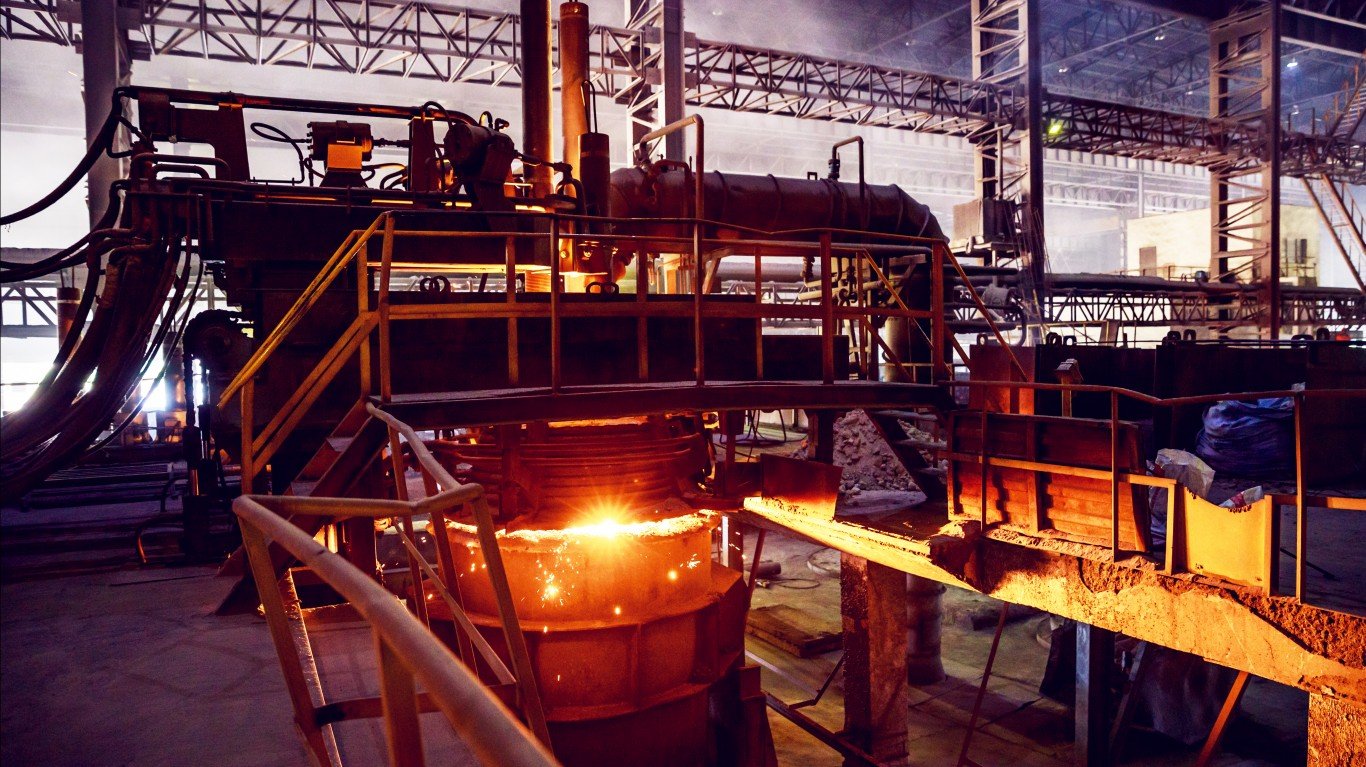
Alabama: Metal-refining furnace operators
> Occupation’s concentration in the state: 6.0 times greater than avg.
> Statewide employment in the occupation: 1,390
> Avg. annual wage for occupation: $35,030 (nationwide: $43,280)
> Share of all US metal-refining furnace operators in Alabama: 8.1%
Birmingham, the largest city in Alabama, is the only place in the world where there are large deposits of coal, iron ore, and limestone — the three raw ingredients needed to make iron — close together. Though the industry has waned in the past few decades, there are over 1,000 metal manufacturing companies in Alabama exporting over $1.5 billion in metal goods per year. Metal manufacturers employ furnace operators to melt and refine metal and cast it into steel. These furnace workers are nearly seven times more concentrated in Alabama than they are nationwide.
[in-text-ad]
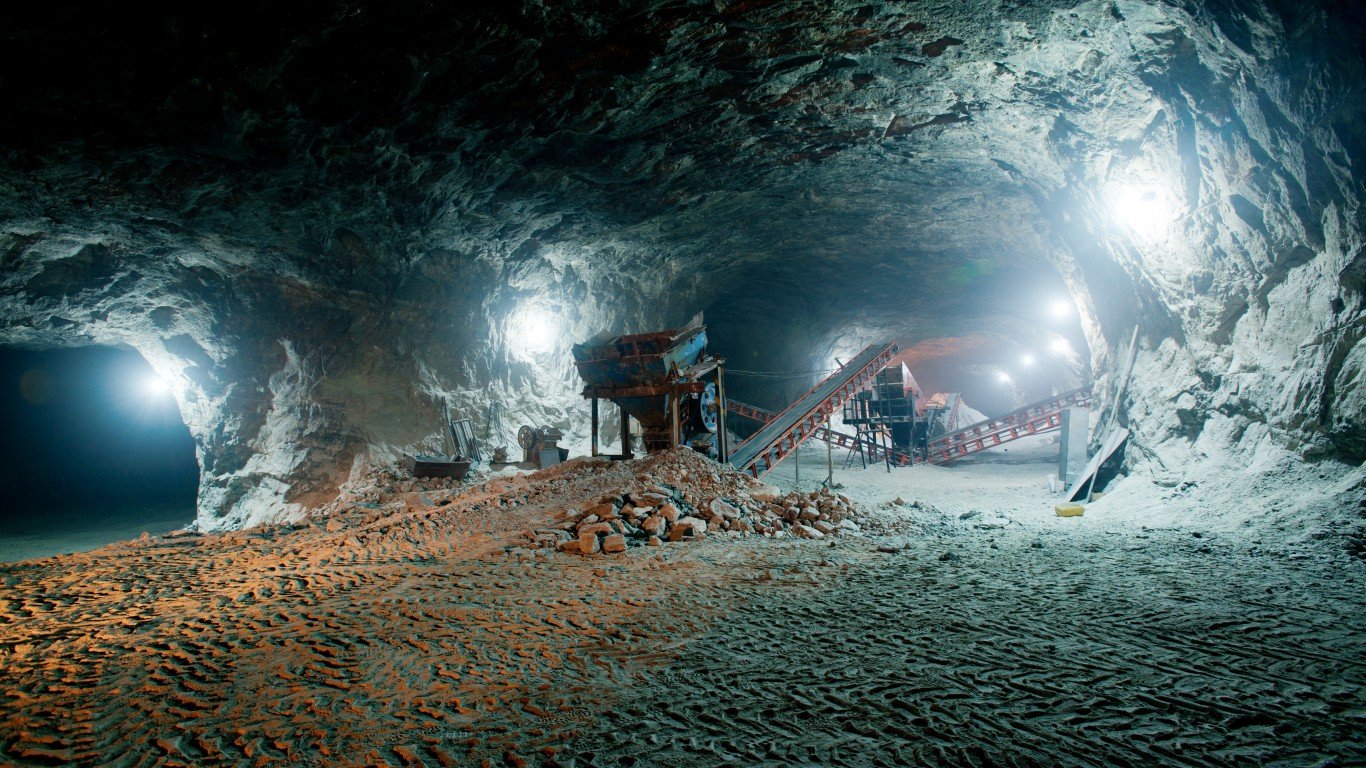
Alaska: Misc. underground mining machine operators and extraction workers
> Occupation’s concentration in the state: 15.5 times greater than avg.
> Statewide employment in the occupation: 460
> Avg. annual wage for occupation: $64,860 (nationwide: $52,280)
> Share of all US misc. underground mining machine operators and extraction workers in Alaska: 3.3%
Underground mining machine operators and extraction workers are about 15.5 times more concentrated in Alaska’s labor force than they are in the national labor force. Resource extraction is an economic pillar in the state, and mining operations across Alaska generate billions of dollars each year. Metals like silver, gold, zinc, and lead are mined in the state, as are construction materials like sand, gravel, and rock in addition to coal. Some of the mining operations in the state are among the most productive in the country, including the Red Dog and Greens Creek mines.
Jobs in Alaska’s mining industry are relatively well paying. The average mining machine operator and extraction worker earns nearly $65,000 a year, over $12,000 more than the average American working in the same field.

Arizona: Plasterers and stucco masons
> Occupation’s concentration in the state: 4.4 times greater than avg.
> Statewide employment in the occupation: 2,340
> Avg. annual wage for occupation: $47,300 (nationwide: $49,710)
> Share of all US plasterers and stucco masons in Arizona: 8.6%
Arizona is home to parts of the Sonoran, Mojave, and Chihuahuan deserts — and building materials commonly used in other parts of the country do not hold up especially well in desert conditions. Stucco, however, does. Stucco plaster made up of a mixture of sand, Portland cement, lime, and water is used in homes across Arizona.
There are over 2,300 plasterers and stucco masons working in Arizona, or about 8.6% of all Americans working in the profession nationwide.

Arkansas: Misc. food processing workers
> Occupation’s concentration in the state: 11.5 times greater than avg.
> Statewide employment in the occupation: 4,080
> Avg. annual wage for occupation: $26,570 (nationwide: $28,820)
> Share of all US food processing workers in Arkansas: 9.5%
Miscellaneous food processors are over 11 times more concentrated in the Arkansas workforce than they are in the U.S. workforce overall. The relative commonality of food processing jobs is due largely to the presence of several major food companies. For example, Frito-Lay, the company behind snacks like Doritos, Cheetos, Tostitos, and Funyuns, has a plant in Jonesboro with over 700 full-time employees. Additionally, Tyson Foods, a company that produces 1 out of every 5 pounds of chicken, beef, and pork in the United States is headquartered in Springdale, Arkansas.
[in-text-ad-2]

California: Farmworkers and laborers
> Occupation’s concentration in the state: 5.8 times greater than avg.
> Statewide employment in the occupation: 201,440
> Avg. annual wage for occupation: $27,550 (nationwide: $27,780)
> Share of all US farmworkers and laborers in California: 68.2%
Thanks to the state’s climate, farming is a $50 billion a year business in California. Over one-third of vegetables grown in the United States come from California, as do over two-thirds of fruits and nuts. Parts of the state, like Napa and Sonoma, are renowned for their winemaking — one of the fastest growing industries in the United States.
Over 68% of American crop, nursery, and greenhouse farm workers are employed in California. Employment in those jobs is nearly six times more concentrated in the state than it is nationwide.

Colorado: Atmospheric and space scientists
> Occupation’s concentration in the state: 5.7 times greater than avg.
> Statewide employment in the occupation: 970
> Avg. annual wage for occupation: N/A (nationwide: $97,160)
> Share of all US atmospheric and space scientists in Colorado: 10.4%
Over 10% of all atmospheric and space scientists nationwide work in Colorado. The National Center for Atmospheric Research, a federally funded research center, is headquartered in Boulder. The state is also home to over 400 aerospace companies. defense contractor behemoth Lockheed Martin has a missile program near Denver and ranks among the largest private employers in the area.
Atmospheric and space scientists are about six times more concentrated in the state’s labor force compared to the national labor force
[in-text-ad]

Connecticut: Actuaries
> Occupation’s concentration in the state: 5.3 times greater than avg.
> Statewide employment in the occupation: 1,350
> Avg. annual wage for occupation: N/A (nationwide: $120,970)
> Share of all US actuaries in Connecticut: 6.1%
Actuaries are financial risk analysts and are integral to the insurance industry. Actuaries are about five times more concentrated in Connecticut than they are in the U.S. labor force.
Hartford, the capital of Connecticut, is known as the Insurance Capital of the World, due to the concentration of insurance companies headquartered in the city. Though in recent years some companies have relocated out of the area, over 100 insurance companies still operate in Connecticut.

Delaware: Chemists
> Occupation’s concentration in the state: 5.3 times greater than avg.
> Statewide employment in the occupation: 1,350
> Avg. annual wage for occupation: $106,020 (nationwide: $84,150)
> Share of all US chemists in Delaware: 1.6%
Chemists are over five times more concentrated in the Delaware labor force than they are in the U.S. labor force as a whole. Due to the presence of major chemical companies — including DuPont, AstraZeneca, and Hercules — Wilmington, Delaware, is known as the chemical capital of the world.
Jobs for chemists in Delaware tend to be higher paying than those in much of the rest of the country. The average annual salary for a chemist in the state is $106,020 — over $20,000 more than it is nationwide.
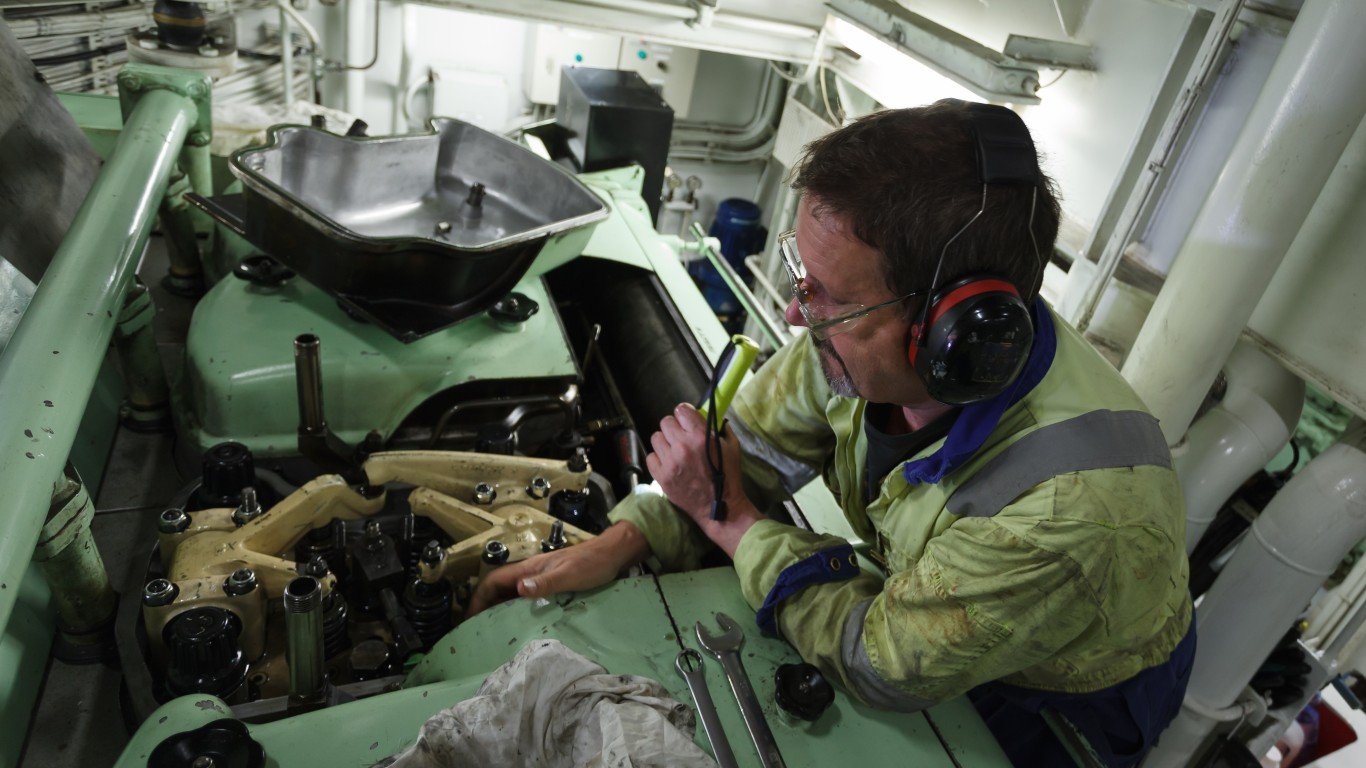
Florida: Ship engineers
> Occupation’s concentration in the state: 3.0 times greater than avg.
> Statewide employment in the occupation: 1,520
> Avg. annual wage for occupation: $67,270 (nationwide: $79,540)
> Share of all US ship engineers in Florida: 18.1%
Ship engineers oversee technician crews aboard commercial, research, or military vessels. With the most shoreline in the continental United States, Florida accounts for over 18% of U.S. employment of ship engineers.
Located at a crossroads of North and South America, Miami alone has one of the busiest — and increasingly trafficked — ports in the country. It is also one of the deepest ports in the country, which allows access to larger vessels not able to safely navigate ports with shallower waters.
[in-text-ad-2]

Georgia: Textile winding, twisting, and drawing out machine operators
> Occupation’s concentration in the state: 12.7 times greater than avg.
> Statewide employment in the occupation: 12,070
> Avg. annual wage for occupation: $30,620 (nationwide: $30,740)
> Share of all US textile winding, twisting, and drawing out machine operators in Georgia: 38.7%
Nearly 40% of Americans who work as textile winding, twisting, and drawing out machine operators are employed in Georgia. Historically, textile mills were an economic pillar in Columbus, Georgia, in particular for over a century.
Though the U.S. textile industry declined in much of the late 20th century, in Georgia, it has adapted to new circumstances. To compete, textile companies have changed what they make, and how they make it — shifting to increased automation and reliance on artificial intelligence. The average annual wage for a textile machine operator in Georgia is just $30,620, in line with the national average.
Hawaii: Captains, mates, and pilots of water vessels
> Occupation’s concentration in the state: 8.8 times greater than avg.
> Statewide employment in the occupation: 1,270
> Avg. annual wage for occupation: $57,070 (nationwide: $87,420)
> Share of all US captains, mates, and pilots of water vessels in Hawaii: 3.8%
In Hawaii, a group of over 100 islands in the Pacific, separated by the U.S. mainland by over 2,000 miles of ocean, there are nearly 1,300 people working as captains, mates, and pilots of water vessels — nearly nine times the concentration of such workers in the U.S. as a whole.
Hawaii is also home to the port of Honolulu, which is among the 30 largest in the United States. People working as boat or ship captains or pilots are required to hold a license from the U.S. Coast Guard.
[in-text-ad]

Idaho: Nuclear technicians
> Occupation’s concentration in the state: 10.4 times greater than avg.
> Statewide employment in the occupation: 330
> Avg. annual wage for occupation: $75,550 (nationwide: $82,710)
> Share of all US nuclear technicians in Idaho: 5.1%
Nuclear technicians are over 10 times more concentrated in Idaho than they are nationwide. When it came online in 1951, the Idaho National Laboratory was the first nuclear power plant in U.S. history. Though it is now strictly a federal nuclear research center and no longer produces electricity, it is one of the largest employers in the state. Additionally, though there are no commercial nuclear power plants in operation in Idaho, by 2026, the INL plans to generate power through 12 small nuclear reactors.

Illinois: Rail car repairers
> Occupation’s concentration in the state: 2.9 times greater than avg.
> Statewide employment in the occupation: 3,120
> Avg. annual wage for occupation: $55,510 (nationwide: $56,810)
> Share of all US rail car repairers in Illinois: 12.0%
Rail car repairers are nearly three times more concentrated in Illinois than they are nationwide. The state alone employs about 12% of all rail car repairers nationwide. Their concentration in the state is due in large part to Chicago’s distinction as the most important rail hub in North America.
Chicago, the largest city in the Midwest, is a major interchange point for railroad freight with an estimated 500 trains passing through per day, and is also a major Amtrak hub. The city itself has one of the most extensive commuter rail systems in the United States, serving hundreds of thousands of residents each day.
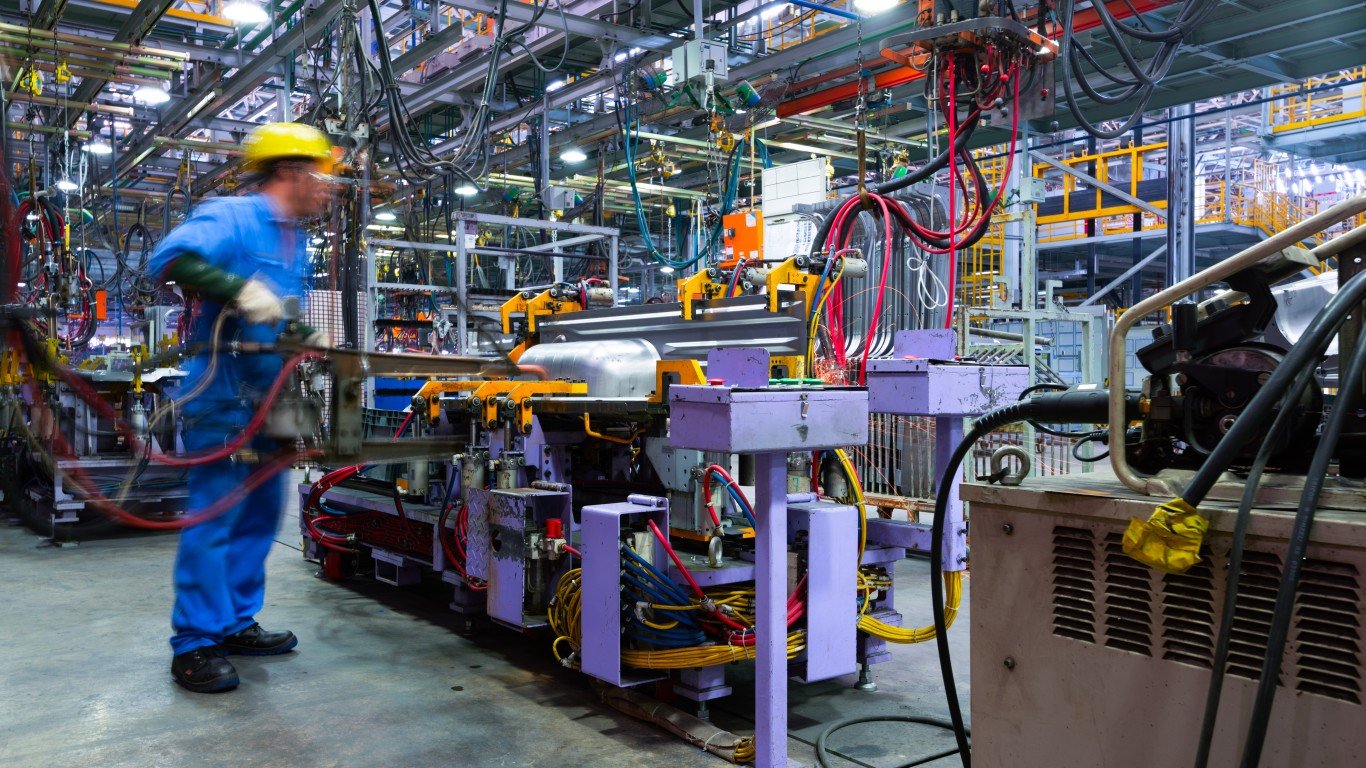
Indiana: Engine and other machine assemblers
> Occupation’s concentration in the state: 8.3 times greater than avg.
> Statewide employment in the occupation: 7,990
> Avg. annual wage for occupation: N/A (nationwide: $46,570)
> Share of all US engine assemblers in Indiana: 17.4%
Indiana is a major American manufacturing hub, and that reputation is partially driven by engine and automotive production in the state. Over 17% of all Americans working as engine assemblers are employed in Indiana.
Fiat Chrysler has an engine plant in Kokomo, Indiana, and diesel engine manufacturer Cummins also employs thousands in plants in southern Indiana. Other automotive giants with assembly plants in the state include General Motors, Honda, Subaru, and Toyota. Industrial equipment company Caterpillar also has an engine production facility in Lafayette, Indiana.
[in-text-ad-2]

Iowa: Wind turbine service technicians
> Occupation’s concentration in the state: 7.6 times greater than avg.
> Statewide employment in the occupation: 480
> Avg. annual wage for occupation: $57,510 (nationwide: $56,700)
> Share of all US wind turbine service technicians in Iowa: 8.1%
Over 8% of all wind turbine service technicians in the United States are employed in Iowa. The state produces more energy from wind than every other state with the exception of Oklahoma and Texas. There are about 5,100 wind turbines spread across the state, though most are located in northwestern Iowa where winds are the strongest. Service technicians are needed to install, maintain, and repair wind turbines in the state.
The average annual wage for a wind turbine technician in Iowa is $57,510, in line with the national average of $56,700.

Kansas: Aircraft systems assemblers
> Occupation’s concentration in the state: 21.8 times greater than avg.
> Statewide employment in the occupation: 8,860
> Avg. annual wage for occupation: $53,460 (nationwide: $56,460)
> Share of all US aircraft systems assemblers in Kansas: 20.6%
There are nearly 43,000 Americans working as aircraft systems assemblers nationwide, and over 20% of them work in Kansas.
Aircraft systems assemblers fit and install various aircraft components, including wings, landing gear, and heating systems. Multiple companies, including Cessna, Spirit AeroSystems, and Bombardier Learjet employ thousands in their Wichita locations. The city’s identity as an aircraft manufacturing hub began in World War II, as Wichita’s economy boomed thanks to demand for military aircraft.
[in-text-ad]

Kentucky: Farm and home management educators
> Occupation’s concentration in the state: 9.5 times greater than avg.
> Statewide employment in the occupation: 1,070
> Avg. annual wage for occupation: $51,080 (nationwide: $52,720)
> Share of all US farm and home management educators in Kentucky: 12.3%
Farm and home management educators are the most iconic job in Kentucky. They are effectively consultants for farmers and those engaged in home economics activities. Such advisors are about 10 times more common in Kentucky’s labor pool than in the U.S. labor pool as a whole. Agriculture and animal raising are big business in Kentucky as the state is home to over 2 million head of cattle.
The average annual wage for a farm and home management educator in Kentucky is $51,080, slightly below the national average of $52,720.
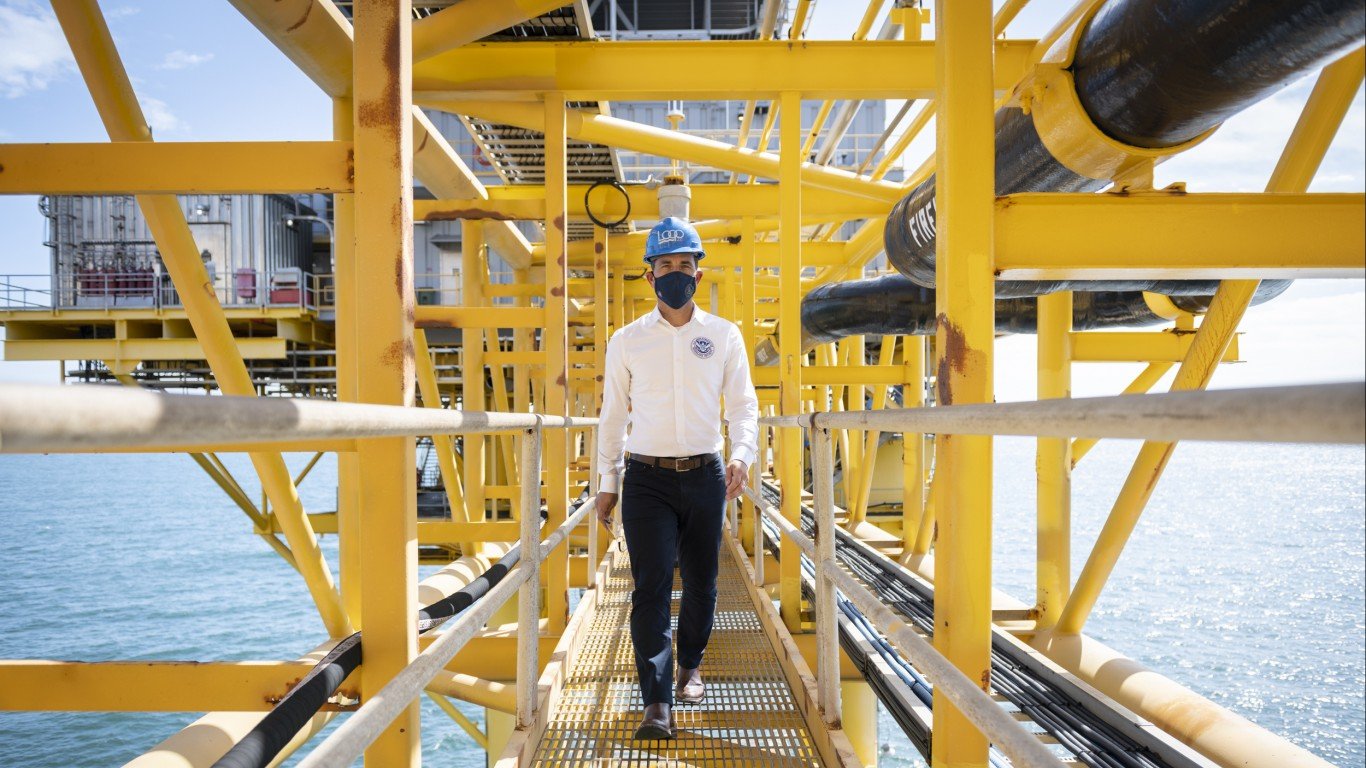
Louisiana: Sailors and marine oilers
> Occupation’s concentration in the state: 17.9 times greater than avg.
> Statewide employment in the occupation: 7,340
> Avg. annual wage for occupation: N/A (nationwide: $53,250)
> Share of all US sailors and marine oilers in Louisiana: 23.5%
Sailors and marine oilers, the most iconic job in Louisiana, perform a wide variety of tasks on board ships, from looking out for obstructions on the water to maintaining ship equipment and using emergency equipment as necessary. In addition to about 7,700 miles of coastline along the Gulf of Mexico, wetlands cover about a third of the state’s total land area. Marine-based economic activity in Louisiana ranges from fishing to offshore oil production, and more than 23% of all U.S. sailors and marine oilers work in the state.

Maine: Shoe machine operators
> Occupation’s concentration in the state: 18.7 times greater than avg.
> Statewide employment in the occupation: 390
> Avg. annual wage for occupation: $35,310 (nationwide: $30,540)
> Share of all US shoe machine operators in Maine: 7.8%
Though there are only about 400 shoe machine operators and tenders in Maine, they hold the most iconic job in the state, accounting for nearly 8% of total U.S. employment in the industry. While there are a few smaller shoe-making operations in the state, industry employment is driven largely by the presence of New Balance factories in Norridgewock, Skowhegan, and Norway and L.L. Bean plants in Brunswick and Lewiston that churn out the company’s iconic boots.
Shoe machine operators tend to have slightly higher incomes in Maine than they do on average nationwide. The average annual wage in the occupation is $35,310 in Maine, compared to $30,540 across the U.S. as a whole.
[in-text-ad-2]

Maryland: Physicists
> Occupation’s concentration in the state: 6.1 times greater than avg.
> Statewide employment in the occupation: 1,880
> Avg. annual wage for occupation: $121,450 (nationwide: $131,080)
> Share of all US physicists in Maryland: 11.2%
Physicists are about six times more concentrated in the Maryland workforce than they are in the national workforce. Generally, physicists study the ways in which various forms of matter and energy interact — and there are many companies and agencies in Maryland that depend on their work.
Much of Maryland is within commuting distance of Washington D.C., and it is no coincidence that there are many defense contractors, which employ physicists, operating in the state. These include some of the largest defense companies in the world such as Lockheed Martin, Northrop Grumman, and BAE Systems. The Johns Hopkins University Applied Physics Laboratory, located between Baltimore and the nation’s capital, is also a major employer of physicists.

Massachusetts: Medical scientists
> Occupation’s concentration in the state: 5.4 times greater than avg.
> Statewide employment in the occupation: 16,860
> Avg. annual wage for occupation: $106,610 (nationwide: $98,770)
> Share of all US medical scientists in Massachusetts: 13.3%
Medical scientists, excluding epidemiologists, are over five times more common in the Massachusetts workforce than they are in the national workforce. Generally, they conduct research with the goal of improving overall human health. Medical scientists typically hold a doctorate, and over 13% of all Americans working in the profession work in Massachusetts.
The state is home to several medical colleges and universities, including those affiliated with Tufts, Harvard, Northeastern, and the University of Massachusetts. The state is also home to Mass General, which is the largest hospital-based research institution in the country.
[in-text-ad]

Michigan: Engine and other machine assemblers
> Occupation’s concentration in the state: 7.0 times greater than avg.
> Statewide employment in the occupation: 9,580
> Avg. annual wage for occupation: $51,750 (nationwide: $46,570)
> Share of all US engine and other machine assemblers in Michigan: 20.8%
In Michigan, engine and other machine assemblers are seven times more concentrated than they are nationwide. Michigan — more specifically, Detroit — has been America’s automotive manufacturing hub for over a century. Ford, General Motors, and Fiat Chrysler all have their American headquarters in Michigan. Michigan is home to over one-fifth of Americans working as engine and other machine assemblers.
Engine and other machine assemblers tend to have slightly higher incomes in Michigan than they do nationwide. The average annual wage in the occupation is $51,750 in Michigan, compared to $46,570 across the U.S. as a whole.

Minnesota: Wind turbine service technicians
> Occupation’s concentration in the state: 4.3 times greater than avg.
> Statewide employment in the occupation: 500
> Avg. annual wage for occupation: $59,320 (nationwide: $56,700)
> Share of all US wind turbine service technicians in Minnesota: 8.4%
Over 8% of all wind turbine service technicians in the United States are employed in Minnesota. The state ranks among the top 10 nationwide for wind power generation — largely from wind turbines located in the prairies in the southwestern part of the state. Service technicians are needed to install, maintain, and repair the turbines that convert wind into electricity.
The average annual wage for a wind turbine technician in Minnesota is $59,320, slightly higher than the national average of $56,700.

Mississippi: Fallers
> Occupation’s concentration in the state: 10.7 times greater than avg.
> Statewide employment in the occupation: 400
> Avg. annual wage for occupation: $42,870 (nationwide: $49,670)
> Share of all US fallers in Mississippi: 8.2%
In Mississippi, about two-third of landmass is forested — and fallers, or those who fell trees using axes or saws, are the most iconic workers in the state. Fallers are nearly 11 times more concentrated in Mississippi than they are nationwide.
Wood and wood waste are a major source of energy in Mississippi, accounting for about 80% of the state’s renewable energy production. The history of the state’s economy is rooted in logging, as railroads construction in the late 1800s made large scale sawmills possible by opening up new markets for finished lumber and opening up new logging areas to lumber companies. The number of mills in the state jumped from 295 in 1880 to over 600 in 1899. By the early 1900s, Mississippi produced more lumber than every other state except for Washington and Louisiana.
[in-text-ad-2]

Missouri: Locomotive engineers
> Occupation’s concentration in the state: 2.0 times greater than avg.
> Statewide employment in the occupation: 1,350
> Avg. annual wage for occupation: $77,660 (nationwide: $71,570)
> Share of all US locomotive engineers in Missouri: 3.8%
Locomotive engineers are twice as concentrated in Missouri as they are nationwide. Few states depend on railroads like Missouri. The state’s two largest cities, St. Louis and Kansas City, are among the top three largest rail transportation centers in America. The state has over 1,300 locomotive engineers, who drive both passenger and freight trains.
Locomotive engineers tend to have considerably higher incomes in Missouri than they do on average nationwide. The average annual wage in the occupation is $77,660 in Missouri, compared to $71,570 across the U.S. as a whole.

Montana: Forest and conservation technicians
> Occupation’s concentration in the state: 14.2 times greater than avg.
> Statewide employment in the occupation: 860
> Avg. annual wage for occupation: $45,490 (nationwide: $45,860)
> Share of all US forest and conservation technicians in Montana: 4.5%
Forest and conservation technicians work to conserve soil, water, forests, and other natural resources. Such workers are about 14 times more concentrated in Montana than they are nationwide. Montana is home to 15 protected wilderness areas that span more than 3.4 million acres. Healthy forests are a critical part of the state’s identity, as over 80% of state residents regularly engage in outdoor recreation — and much of it on public land.
The average annual wage for forest and conservation technicians in Montana is just $45,490, in line with the national average.
[in-text-ad]
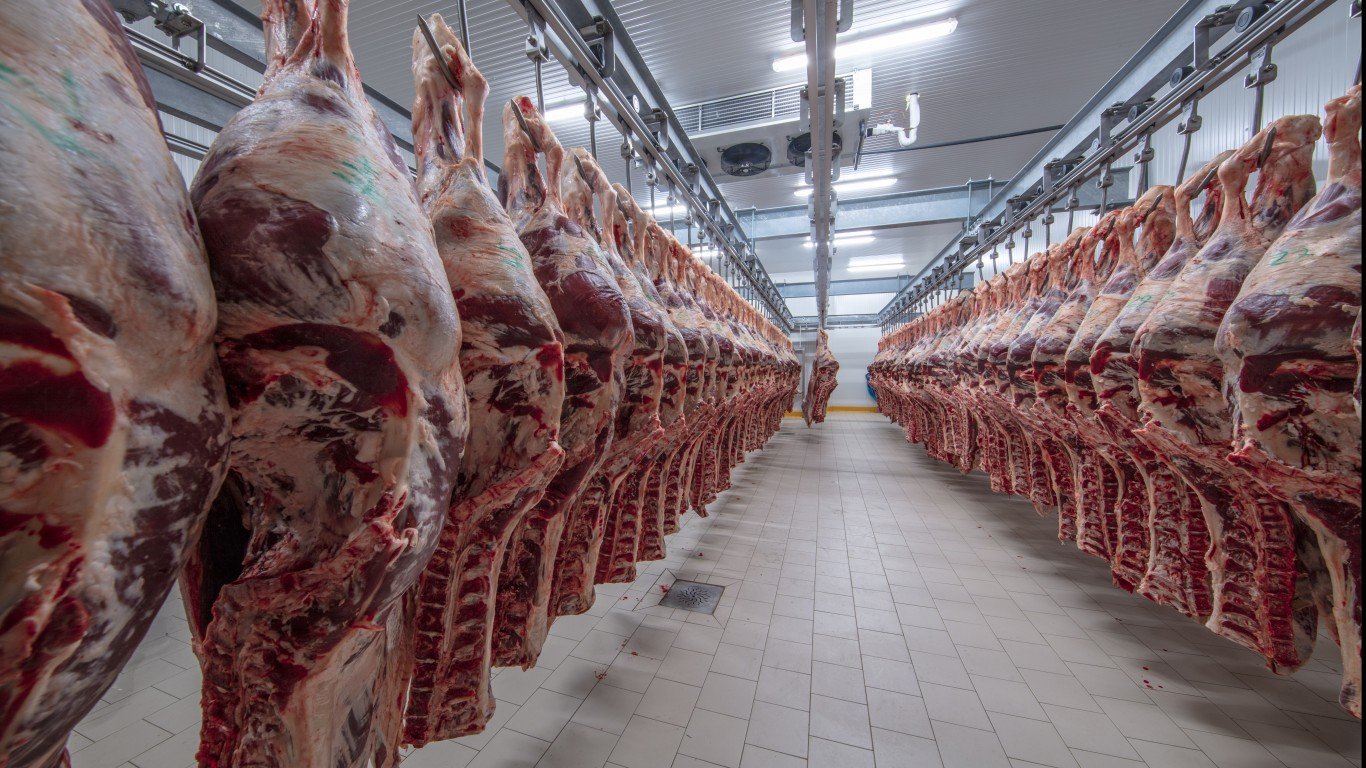
Nebraska: Meat, poultry, and fish cutters and trimmers
> Occupation’s concentration in the state: 8.9 times greater than avg.
> Statewide employment in the occupation: 9,200
> Avg. annual wage for occupation: $34,720 (nationwide: $28,810)
> Share of all US meat, poultry, and fish cutters and trimmers in Nebraska: 6.0%
Meat, poultry, and fish cutters and trimmers are about nine times more concentrated in Nebraska’s labor force than in the U.S. labor force. The state led the nation in commercial cattle slaughter in 2020 at nearly 7 million head. Farming and ranching are possible in the state as much of the landscape makes for ideal grazing pastures for cattle.
Meat, poultry, and fish cutters and trimmers tend to have slightly higher incomes in Nebraska than they do on average nationwide. The average annual wage in the occupation is $34,720 in Nebraska, compared to $28,810 across the U.S. as a whole.

Nevada: Gambling dealers
> Occupation’s concentration in the state: 24.1 times greater than avg.
> Statewide employment in the occupation: 22,580
> Avg. annual wage for occupation: $18,750 (nationwide: $23,980)
> Share of all US gambling dealers in Nevada: 22.8%
Las Vegas and its casino industry is the lifeblood of Nevada’s economy — and gambling dealers are the state’s most iconic occupation. There are over 22,500 gaming dealers working in Nevada, operating card tables and other casino games and distributing winnings. Nearly 23% of all American gaming dealers work in Nevada.
Gaming dealers are not highly compensated in Nevada, however. Their average annual wage is just $18,750. Nationwide, the typical gambling dealer earns nearly $24,000 a year.
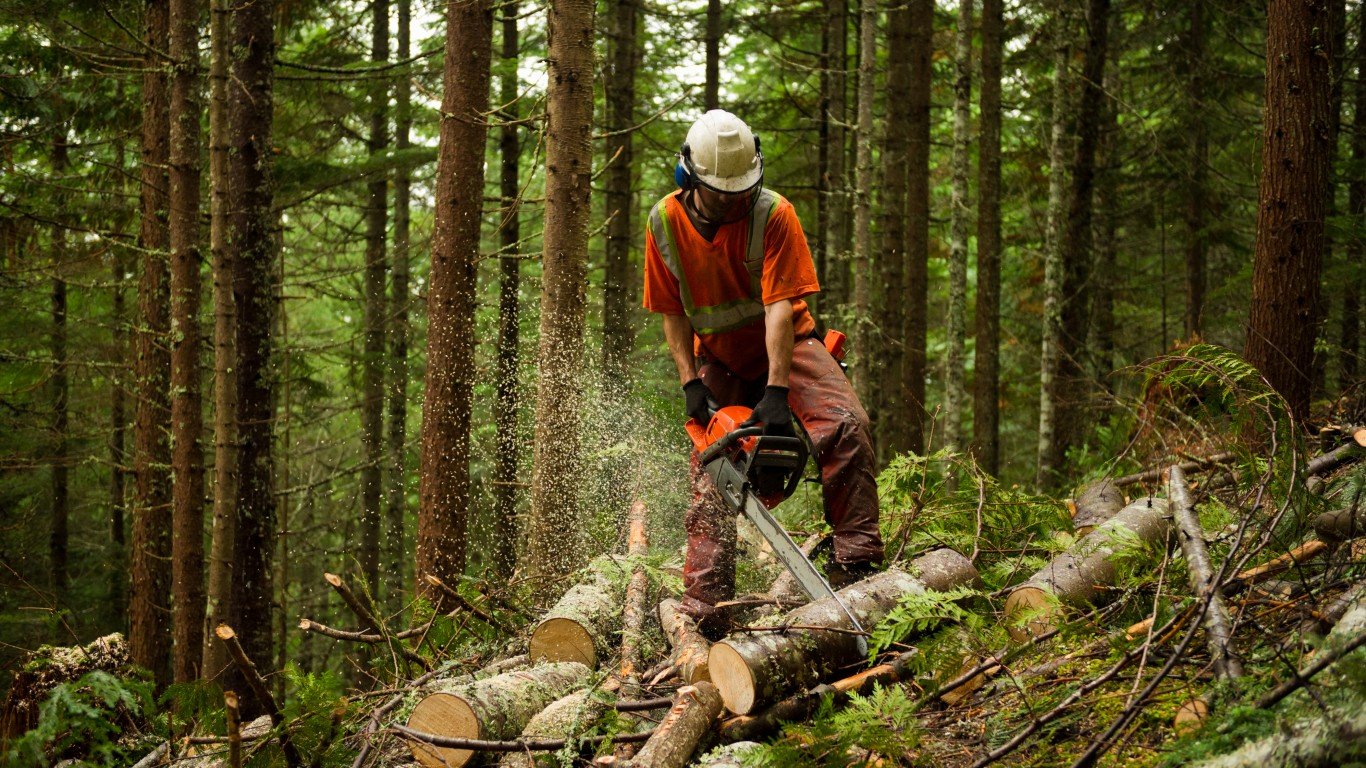
New Hampshire: Log graders and scalers
> Occupation’s concentration in the state: 4.7 times greater than avg.
> Statewide employment in the occupation: 70
> Avg. annual wage for occupation: $40,310 (nationwide: $39,110)
> Share of all US log graders and scalers in New Hampshire: 2.1%
About 84% of New Hampshire is forested land, and partially as a result, forestry is a $1.4 billion industry in the state. New Hampshire is a relatively small state, and though there are only about 70 people working as log graders and scalers in the state, the occupation is still about five times more concentrated in New Hampshire than it is nationwide. The 70 log graders and scalers, who inspect logs to estimate their value, make up a small share of the roughly 1,700 people working in the state as loggers or foresters.
The average annual wage for loggers and scalers in New Hampshire is $40,310, about $1,200 more than the average income among all log graders and scalers nationwide.
[in-text-ad-2]

New Jersey: Biochemists and biophysicists
> Occupation’s concentration in the state: 8.3 times greater than avg.
> Statewide employment in the occupation: 7,280
> Avg. annual wage for occupation: N/A (nationwide: $108,180)
> Share of all US biochemists and biophysicists in New Jersey: 23.2%
In New Jersey, biochemists and biophysicists are 8.3 times more concentrated than they are nationwide. Generally, these occupations consist of studying the chemical and physical qualities of living things and of biological processes. Many working in the field are employed by pharmaceutical companies — and, home to 14 of the world’s 20 largest pharmaceutical companies, New Jersey has been dubbed “The Medicine Chest of the World.”
Pharmaceutical companies operating in the state include Bayer Healthcare, Bristol-Myers Squibb, Johnson & Johnson, Merck, and Novartis. Of the 31,400 Americans working as biochemists and biophysicists, 23.2% work in New Jersey.

New Mexico: Physicists
> Occupation’s concentration in the state: 18.5 times greater than avg.
> Statewide employment in the occupation: 1,740
> Avg. annual wage for occupation: $166,720 (nationwide: $131,080)
> Share of all US physicists in New Mexico: 10.4%
More than one in every 10 Americans working as physicists are employed in New Mexico. The concentration of physicists in the state is directly attributable to the Los Alamos National Laboratory, located less than 60 miles north of Albuquerque. The famed research institute where the atomic bomb was developed continues to be a hub of scientific research for the purposes of national security.
Physicists tend to have considerably higher incomes in New Mexico than they do on average nationwide. The average annual wage in the occupation is $166,720 in New Mexico, compared to $131,080 across the U.S. as a whole.
[in-text-ad]

New York: Fashion designers
> Occupation’s concentration in the state: 5.9 times greater than avg.
> Statewide employment in the occupation: 8,460
> Avg. annual wage for occupation: $92,860 (nationwide: $86,110)
> Share of all US fashion designers in New York: 38.4%
There are over 22,000 fashion designers working in the United States — and 38.4% are employed in New York state almost entirely because New York City is one of the world’s premier fashion hubs. The city is home to several top fashion schools, including the Parsons School of Design, Fashion Institute of Technology, and Pratt. A number of industry icons, including Ralph Lauren, Marc Jacobs, Tom Ford, Carolina Herrera, and Donna Karan have close ties to the city. As a result, fashion designer jobs are nearly six times more concentrated in the state than they are nationwide.
Jobs in fashion design tend to be well paying in New York. The average annual wage in the occupation is $92,860 in the state, compared to $86,110 across the U.S. as a whole.

North Carolina: Textile bleaching and dyeing machine operators
> Occupation’s concentration in the state: 7.7 times greater than avg.
> Statewide employment in the occupation: 2,020
> Avg. annual wage for occupation: $29,250 (nationwide: $30,810)
> Share of all US textile bleaching and dyeing machine operators in North Carolina: 23.2%
Textile bleaching and dyeing machine operation is the most iconic job in North Carolina. The concentration of bleaching and dyeing machine operators in the Tarheel State is nearly eight times greater than it is nationwide.
The textile industry has enjoyed a resurgence in several southeastern states, including North Carolina. The region was once a textile production powerhouse until manufacturers began outsourcing production to countries with lower labor costs in the second half of the 20th century. In recent years, companies have moved back to the Southeast U.S. as production facilities there have become more efficient through automation. Today, Gildan Activewear has four production facilities in the state; Everest Textile Co. has one plant; as does textile company King Charles Industries. Nearly one in every four textile bleaching and dyeing machine operators in the United States work in North Carolina.
North Dakota: Wellhead pumpers
> Occupation’s concentration in the state: 29.7 times greater than avg.
> Statewide employment in the occupation: 1,110
> Avg. annual wage for occupation: $57,680 (nationwide: $55,080)
> Share of all US wellhead pumpers in North Dakota: 8.6%
North Dakota produces more crude oil — and has more proved reserves — than any other U.S. state except for Texas. As a result, wellhead pumpers, who work equipment that allows gas and oil to flow from a well, are the most iconic job in the state. Wellhead pumpers are about 30 times more concentrated in North Dakota than they are across the U.S. as a whole.
Wellhead pumpers tend to have slightly higher incomes in North Dakota than their average income nationwide. The average annual wage in the occupation is $57,680 in the state, compared to $55,080 across the U.S. as a whole.
[in-text-ad-2]

Ohio: Foundry mold and coremakers
> Occupation’s concentration in the state: 4.6 times greater than avg.
> Statewide employment in the occupation: 3,000
> Avg. annual wage for occupation: $31,600 (nationwide: $36,920)
> Share of all US foundry mold and coremakers in Ohio: 17.1%
Foundry mold and coremakers use wax and sand to produce molds and cores used in metal castings. In Ohio, these jobs are nearly five times more concentrated than they are nationwide. Though manufacturing is not the economic pillar it once was in Ohio, it has been expanding in recent years. Manufacturing generated over $112 billion in economic output in the state in 2018, up from just $75 billion in 2009.
Though jobs in foundries are more common in Ohio than they are in much of the rest of the country, they are generally not well paying. The average salary among foundry mold and coremakers in the Buckeye State is just $31,600, well below the national average for the occupation of $36,920.
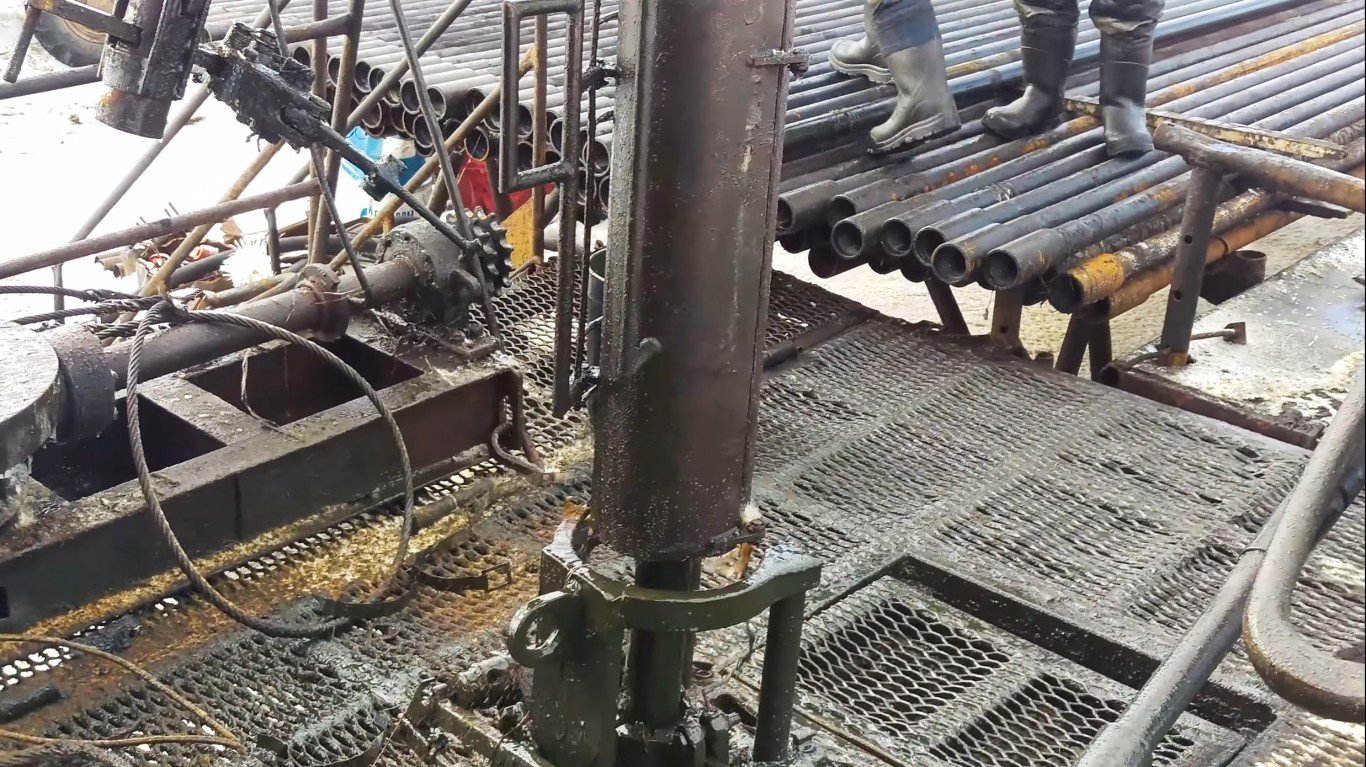
Oklahoma: Oil and gas rotary drill operators
> Occupation’s concentration in the state: 15.0 times greater than avg.
> Statewide employment in the occupation: 3,480
> Avg. annual wage for occupation: $56,300 (nationwide: $57,070)
> Share of all US oil and gas rotary drill operators in Oklahoma: 16.6%
Resource extraction has been an economic pillar in Oklahoma for decades. For 22 years in the early 20th century, Oklahoma produced more oil than other regional oil-producing states including Arkansas, Kansas, Louisiana, New Mexico, and even Texas.
Today, Oklahoma produces more crude oil than all but three other states and has more natural gas reserves than every state except for Texas and Pennsylvania. Like in other resource-rich states, extraction workers are relatively concentrated in Oklahoma. Oil and gas rotary drill operators in particular are about 15 times more concentrated in Oklahoma’s labor force than they are in the U.S. labor force.
[in-text-ad]

Oregon: Misc. logging workers
> Occupation’s concentration in the state: 24.9 times greater than avg.
> Statewide employment in the occupation: 1,210
> Avg. annual wage for occupation: $43,370 (nationwide: $40,390)
> Share of all US misc. logging workers in Oregon: 32.3%
Nearly one-third of all miscellaneous logging workers in the United States are employed in Oregon. Due to rich soil and an ideal climate for forests, Oregon is a national leader in tree growing and lumber production. Nearly half of the state’s 63 million acres are covered in forest, and according to the Oregon Department of Forestry, logging harvests totalled 4.1 billion board feet in 2018.
Logging workers tend to have slightly higher incomes in Oregon than they do on average nationwide. The average annual wage in the occupation is $43,370 in Oregon, compared to $40,390 across the U.S. as a whole.

Pennsylvania: Metal pourers and casters
> Occupation’s concentration in the state: 3.4 times greater than avg.
> Statewide employment in the occupation: 1,080
> Avg. annual wage for occupation: $39,780 (nationwide: $40,850)
> Share of all US metal pourers and casters in Pennsylvania: 13.5%
Though Pennsylvania’s iconic steel industry is a shadow of its former self, with the Bethlehem Steel complex located in the Lehigh Valley shuttering operations in 1995, metallurgy occupations remain in the state. Nearly 14% of all metal pourers and casters in the U.S. work in Pennsylvania. U.S. Steel Corp. — a beneficiary of Trump Administration tariffs on cheaper Chinese steel — announced plans in 2019 to invest over $1 billion in its plants located just outside of Pittsburgh.

Rhode Island: Jewelers and precious stone and metal workers
> Occupation’s concentration in the state: 10.0 times greater than avg.
> Statewide employment in the occupation: 780
> Avg. annual wage for occupation: $38,460 (nationwide: $45,950)
> Share of all US jewelers and precious stone and metal workers in Rhode Island: 3.3%
Jewelers and precious stone and metal work is the most iconic job in Rhode Island. Workers in the field are 10 times more concentrated in the state than they are nationwide.
After a Providence jeweler came up with a new way to plate gold in the late 1700s, factories began to spring up nearby, and the city became a top national and global producer of jewelry. Today, there are still hundreds of workers designing, making, repairing, and selling jewelry in the state. Well-known companies like Tiffany & Co., Shinola, and more have jewelry operations in Rhode Island.
[in-text-ad-2]

South Carolina: Tire builders
> Occupation’s concentration in the state: 13.3 times greater than avg.
> Statewide employment in the occupation: 3,970
> Avg. annual wage for occupation: $50,630 (nationwide: $45,010)
> Share of all US tire builders in South Carolina: 19.1%
South Carolina is the nation’s leading tire manufacturer. Tire builders are over 13 times more concentrated in the state than they are nationwide. Companies like Michelin, Bridgestone, and Continental have manufacturing plants in the state. Over 19% of tire builders in the United States work in South Carolina.
Jobs for tire makers are also relatively well paying in South Carolina. The average annual income for those working in the field is $50,630, over $5,000 more than the average annual wage for all tire builders nationwide.

South Dakota: Soil and plant scientists
> Occupation’s concentration in the state: 14.2 times greater than avg.
> Statewide employment in the occupation: 580
> Avg. annual wage for occupation: $60,000 (nationwide: $69,860)
> Share of all US soil and plant scientists in South Dakota: 4.1%
Soil and plant scientists are about 14 times more concentrated in the South Dakota labor force than they are in the national labor force. The unusually high share of people working in the occupation is likely due in large part to South Dakota’s agriculture industry. There are 19 million acres of cropland in the state, and agriculture has a $20.9 billion annual economic impact, accounting for about 20% of South Dakota’s GDP. Corn, soybeans, and hay are the three largest crops in the state by acre of production.
[in-text-ad]

Tennessee: Musicians and singers
> Occupation’s concentration in the state: 2.6 times greater than avg.
> Statewide employment in the occupation: 2,170
> Avg. annual wage for occupation: N/A
> Share of all US misc. woodworkers in Tennessee: 5.3%
Home to Nashville — also known as Music City — Tennessee’s most iconic jobs are in music.
Musicians and singers are nearly three times more concentrated in Tennessee than they are nationwide.
The Grand Ole Opry in Nashville is one of the most famous venues in American music, and has counted the likes Hank Williams, Johnny Cash, Loretta Lynn, Johnny Paycheck, and Willie Nelson among its members. And for every music legend associated with Nashville, there are hundreds of aspiring artists as well as lesser known session musicians, backup singers, and bar and nightclub performers across Tennessee.

Texas: Petroleum engineers
> Occupation’s concentration in the state: 6.8 times greater than avg.
> Statewide employment in the occupation: 18,720
> Avg. annual wage for occupation: $172,890 (nationwide: $156,780)
> Share of all US petroleum engineers in Texas: 57.4%
There are over 32,600 petroleum engineers in the United States working to develop oil and gas extraction methods — and 57.4% of them work in Texas. Demand for petroleum engineers is driven by the state’s resource wealth. Over 40% of all proved crude oil reserves in the United States are located in Texas, and the state accounts for over 40% of crude oil production in the United States.
Energy giants ExxonMobil, Phillips 66, and Halliburton are all headquartered in the Lone Star State.
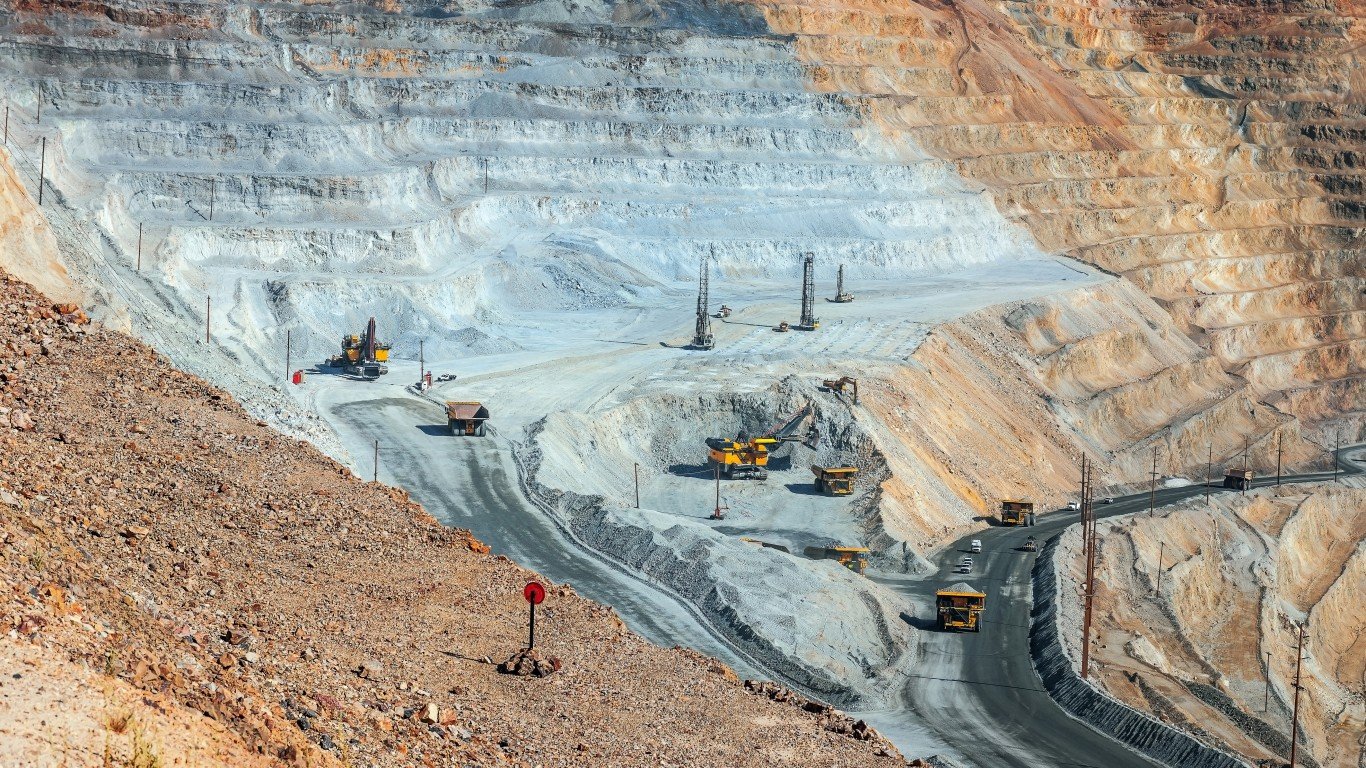
Utah: Continuous mining machine operators
> Occupation’s concentration in the state: 9.3 times greater than avg.
> Statewide employment in the occupation: 1,400
> Avg. annual wage for occupation: $61,100 (nationwide: $56,530)
> Share of all US continuous mining machine operators in Utah: 9.6%
Continuous mining machine operation is the most iconic job in Utah. The job entails controlling self-propelled machines that extract minerals and precious metals from the earth. Continuous mining machine operators are over nine times more concentrated in Utah than they are nationwide.
There are about 25,500 active mining claims in Utah. In addition to gold, silver, copper, and lead mines, the state is also home to the only operating uranium mine in the United States.
[in-text-ad-2]

Vermont: Fallers
> Occupation’s concentration in the state: 4.9 times greater than avg.
> Statewide employment in the occupation: 50
> Avg. annual wage for occupation: $39,450 (nationwide: $49,670)
> Share of all US fallers in Vermont: 1.0%
In Vermont, about 80% of landmass is forested — and fallers, or those who fell trees using axes or saws, are the most iconic workers in the state. Vermont is one of the least populated states in the country, and though there are only about 50 people working as fallers in the state, the occupation is still about five times more concentrated in Vermont than it is nationwide.
The forest products industry in Vermont, which includes fallers, generates about $1.5 billion in economic output annually, supporting other industries including construction, specialty woodworking, and wood heating.

Virginia: Marine engineers and naval architects
> Occupation’s concentration in the state: 8.4 times greater than avg.
> Statewide employment in the occupation: 2,520
> Avg. annual wage for occupation: $92,200 (nationwide: $98,730)
> Share of all US marine engineers and naval architects in Virginia: 22.2%
Marine engineers and naval architects are the most iconic job in Virginia. There are about 11,360 Americans working as marine engineers and naval architects, and 22.2% of them are in Virginia.
The occupation’s concentration in the state is largely due to the presence of major defense contractors. Newport News-based Huntington Ingalls Industries, for example, is the largest military shipbuilding company in the United States — it is the only builder of American aircraft carriers and one of only two builders of nuclear submarines.
[in-text-ad]

Washington: Avionics technicians
> Occupation’s concentration in the state: 6.5 times greater than avg.
> Statewide employment in the occupation: 3,180
> Avg. annual wage for occupation: $83,940 (nationwide: $66,970)
> Share of all US avionics technicians in Washington: 14.6%
More than one in every seven avionics technicians in the U.S. work in Washington state. The job generally entails inspecting, installing, and repairing avionics equipment, which can include radar, navigation, radio, and other systems. Boeing, one of the largest aircraft manufacturers in the world, has a nearly 100 acre manufacturing facility in Everett, Washington. The plant employs thousands and produces the company’s 747, 767, 777, and 787 airplanes.
Jobs for avionics technicians are also relatively well paying in Washington. The average annual income for those working in the field is $83,940, nearly $17,000 more than the average annual wage for all avionics technicians nationwide.

West Virginia: Mining loading and moving machine operators
> Occupation’s concentration in the state: 68.2 times greater than avg.
> Statewide employment in the occupation: 1,370
> Avg. annual wage for occupation: $55,970 (nationwide: $53,730)
> Share of all US mining loading and moving machine operators in West Virginia: 32.6%
Mining loading and moving machine operators are 68 times more concentrated in Virginia than they are across the country as a whole. Such workers are integral to the state’s mining industry — an economic pillar in the state.
Large-scale coal mining operations began in West Virginia in the mid-1800s, and since then, coal mining has been a central part of the state’s economy and identity. There are coal deposits in 53 of West Virginia’s 55 counties. Coal from the more than 160 active mines in the state fuel power plants in about 20 states, and some of it is even shipped abroad.
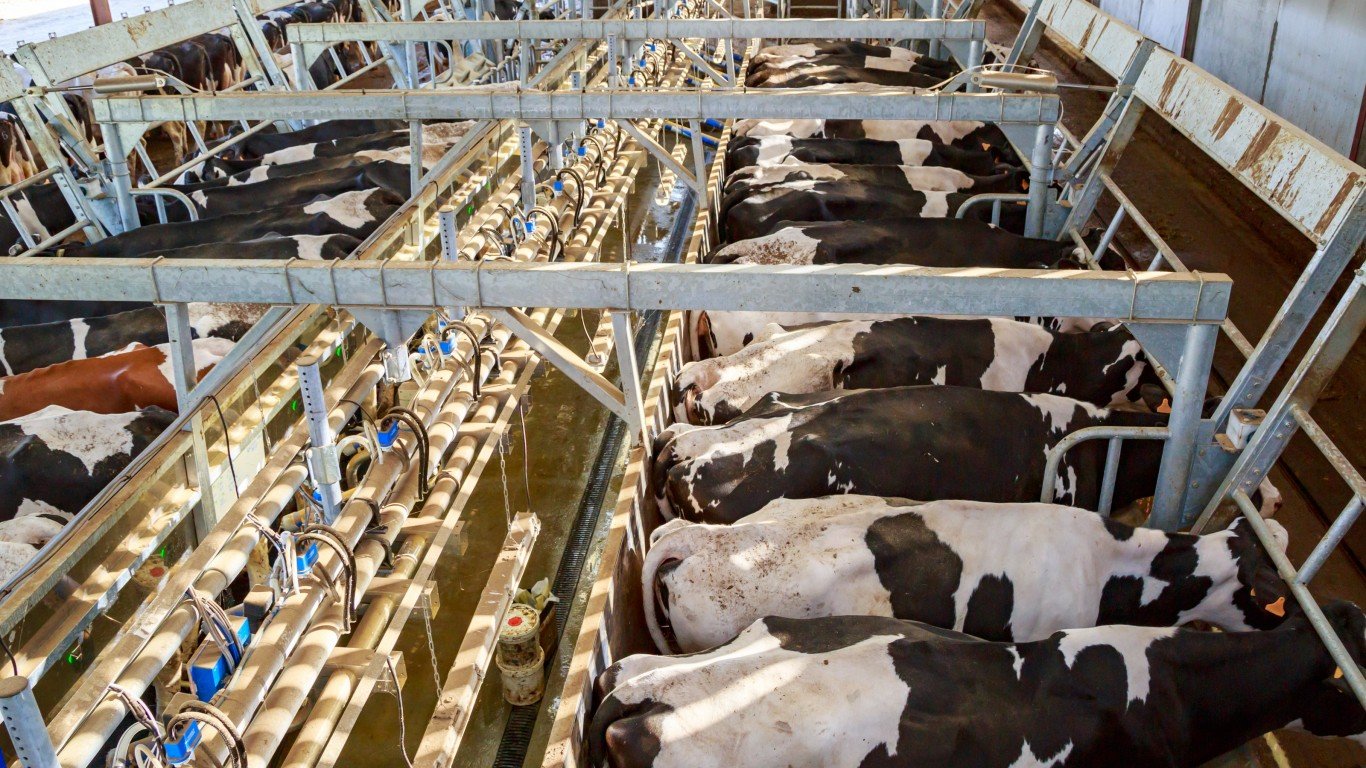
Wisconsin: Animal breeders
> Occupation’s concentration in the state: 8.3 times greater than avg.
> Statewide employment in the occupation: 260
> Avg. annual wage for occupation: $42,260 (nationwide: $46,420)
> Share of all US animal breeders in Wisconsin: 16.1%
Wisconsin has one of the highest concentrations of animal breeders of any state, and 16.1% of all animal breeders in America work in the state. These workers analyze the characteristics of animals to decide which ones will produce the best offspring. In Wisconsin, these considerations are often made in the context of agricultural output.
Wisconsin, known as “America’s Dairyland,” is home to nearly 1.3 million cows across 7,000 farms. Dairy production alone contributes $45.6 billion to the state economy annually. Wisconsin also ranks first in the nation for dairy goats and mink pelts.
[in-text-ad-2]
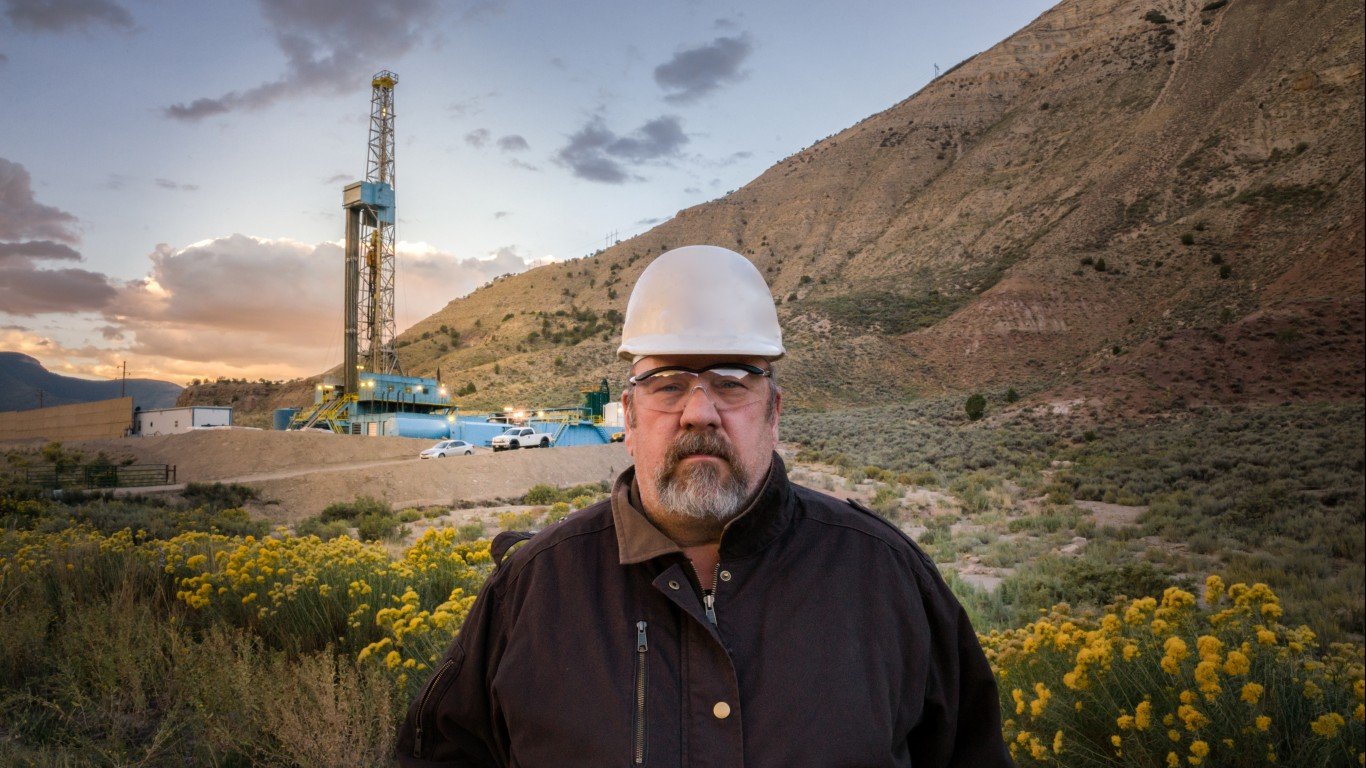
Wyoming: Oil and gas service unit operators
> Occupation’s concentration in the state: 20.2 times greater than avg.
> Statewide employment in the occupation: 1,950
> Avg. annual wage for occupation: $53,840 (nationwide: $51,390)
> Share of all US oil and gas service unit operators in Wyoming: 3.8%
Wyoming is one of the top oil-producing states in the country, so many of the most common professions in the state are in the energy industry — including oil and gas services unit operation, the state’s most iconic job. The state is home to nearly 2,000 oil and gas service unit operators, who control and service machinery used for extracting oil and gas from underground reserves. These workers are 20 times more concentrated in the state’s labor force than they are in the national labor force.
Oil and gas service unit operators tend to have slightly higher incomes in Wyoming than they do on average nationwide. The average annual wage in the occupation is $53,840 in Wyoming, compared to $51,390 across the U.S. as a whole.
Methodology
To determine the most iconic job in every state, 24/7 Wall St. reviewed the relative concentration of occupations within all 50 states with data from the Bureau of Labor Statistics’ May 2019 Occupational Employment Statistics program. Detailed occupations were ranked based on location quotient — the concentration of an occupation within a state’s labor force relative to the concentration in the national labor force — as of 2019. Additional data on median annual wage at the state and national levels also came from the BLS.
Take This Retirement Quiz To Get Matched With A Financial Advisor (Sponsored)
Take the quiz below to get matched with a financial advisor today.
Each advisor has been vetted by SmartAsset and is held to a fiduciary standard to act in your best interests.
Here’s how it works:
1. Answer SmartAsset advisor match quiz
2. Review your pre-screened matches at your leisure. Check out the
advisors’ profiles.
3. Speak with advisors at no cost to you. Have an introductory call on the phone or introduction in person and choose whom to work with in the future
Take the retirement quiz right here.
Thank you for reading! Have some feedback for us?
Contact the 24/7 Wall St. editorial team.
 24/7 Wall St.
24/7 Wall St.
 24/7 Wall St.
24/7 Wall St. 24/7 Wall St.
24/7 Wall St. 24/7 Wall St.
24/7 Wall St.



